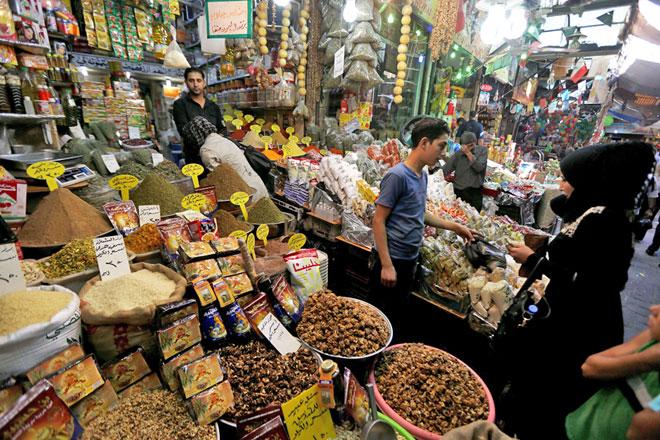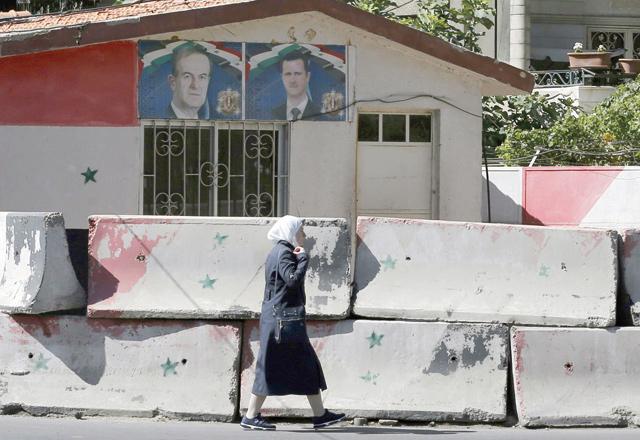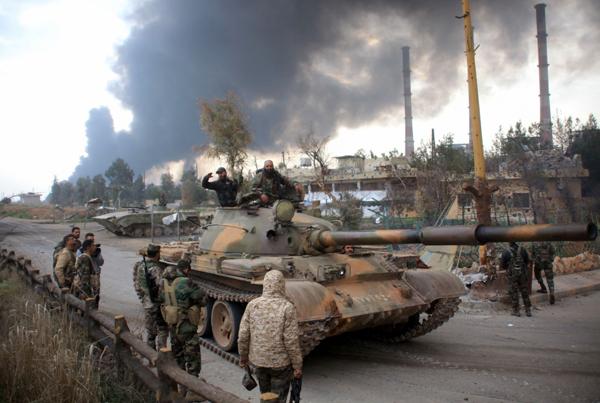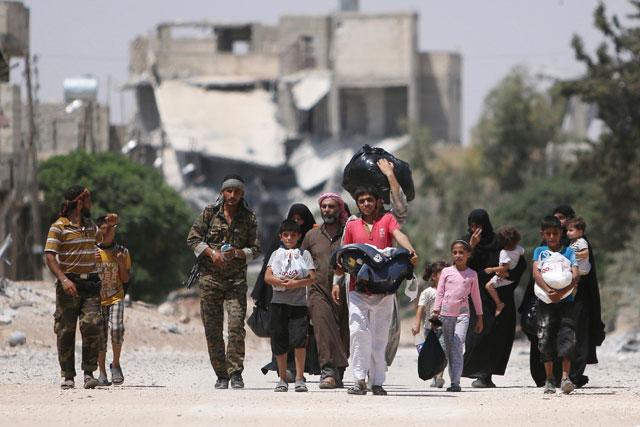You are here
At a Damascus market, divided Syria comes together again
By AFP - Sep 23,2015 - Last updated at Sep 23,2015

Syrians shop at a traditional market in Damascus on Wednesday (AFP photo)
DAMASCUS — Grapes from rebel territory, watermelons from land under jihadist control, potatoes from a regime-held area — every morning the Syria torn apart by war is reunited at Al Hal Souk in Damascus.
More than four years of fighting between President Bashar Al Assad’s regime and disparate rebel groups has left Syria a patchwork of fiefdoms.
Damascus and coastal areas remain under government control, the Daesh terror group holds swathes of the east and the rest of the country is divided among other rebel factions, from Al Qaeda-linked fighters to Kurdish militia.
But at Al Hal Souk wholesale food market in eastern Damascus, amidst the vendors hawking their goods and delivery trucks honking their horns, an echo of the old Syria survives.
“When it comes to food, everyone comes together. The stomach has no political opinions,” said Fares, 32, who sells apples from a farm in Zabadani, about 45 kilometres northwest of Damascus.
The region is famed for its apples but with regular clashes there between the army and rebels, deliveries are irregular.
On one recent day at the market Fares was lucky. Thanks to a ceasefire the day before, boxes of apples were piled high in front of his stall.
“The delivery man arrived today, no problem,” he said with a smile.
The souk — founded when Syria was under French administration from 1920 to 1946 and named after Paris’s famed Les Halles market — holds more than 300 stalls in an area of less than a square kilometre.
In the surrounding streets, delivery trucks manouevre through narrow passages, jostling for space with cars and porters.
‘All provinces of Syria’
The market sits on the edge of the Damascus suburb of Jobar, a frontline that has seen heavy clashes. Some 15 people were killed and dozens wounded as shells fell on the area in recent days, but the traffic at the market continues.
Between 6:00am and noon every day, more than 400 tonnes of goods change hands, making their way from the market throughout Damascus and the rest of the country.
Truckers like 30-year-old Abu Abdo are the market’s lifeblood, carrying produce on often-fraught journeys through territory in many different hands.
“It took me 17 hours to bring these 15 tonnes of red and green chilli peppers from Deir Hafer, in the countryside of Aleppo, passing through Raqa and Palmyra,” both areas held by Daesh, Abu Abdo said.
“I’m going to sleep for one night and then bring tomatoes to Al Bab,” a city in Aleppo province also held by Daesh.
Abu Abdo’s case is hardly unusual.
At Al Hal, the grapes and tomatoes come from Daraa province in the south, which is mainly in the hands of rebel forces. The watermelons are from Jabal Al Sheikh, on the edge of the Israeli-occupied Golan Heights and under the control of Al Nusra Front, the local branch of Al Qaeda.
The courgettes are from Idlib province, recently conquered by a mainly Islamist rebel alliance. Citrus fruits are from Assad’s coastal heartland, potatoes from regime-controlled Hama province and the onions come from northeastern Hasakeh, held by the Kurds.
“All the provinces of Syria are reunited at this market,” said stall-owner Abu Mohammad, his face hidden behind a bushy grey beard.
“It would be a huge disaster if it closed,” he said, watching the scales as his employees weighed hefty sacks of aubergines, green peppers and tomatoes.
A respite from war
“I’ve been working here for 30 years. Never have I closed my shop, even in the worst moments of the war. I receive merchandise from all of Syria — people need to eat.”
The war has sparked an enormous humanitarian crisis in Syria, including food shortages. And most farmers cannot afford to ship their goods across the country.
“Those who come to Damascus only represent a small share of farmers, because the majority don’t have the resources to deliver merchandise,” said Eriko Hibi, the representative of the UN Food and Agriculture Organisation in Syria.
“Many of them cannot because money from the sale may not even cover their costs.”
But some can still afford the journey, making Al Hal Souk one of the few remaining places in Syria where the number plates of the country’s different provinces still mingle.
Truck driver Maher has come from northeastern Hasakeh, under Kurdish control, bringing onions.
“Of course the 800 kilometres are dangerous. I have escaped a regime bombardment. Daesh wanted to cut my throat. The rebels took some of my merchandise,” he said, standing in front his truck.
“I have 10 children and every load brings me 100,000 pounds ($300). Do you have another solution?”
After difficult journeys, Maher added, the market offers a kind of respite.
“Here it feels like Syria has not been torn apart, that people from each region can find each other and talk without hatred.”
Related Articles
DAMASCUS, Syria — In his beloved yellow taxi, Abu Ayman zigzags through the streets of Syria's capital Damascus, delighted that the security
ALEPPO — Hardened after years of war, Syrians are struggling to believe that the ceasefire deal announced for this weekend will put an end t
BEIRUT — Syrian regime forces redeployed on Sunday to try to avoid being surrounded in neighbourhoods they control in Aleppo, after a rebel



















